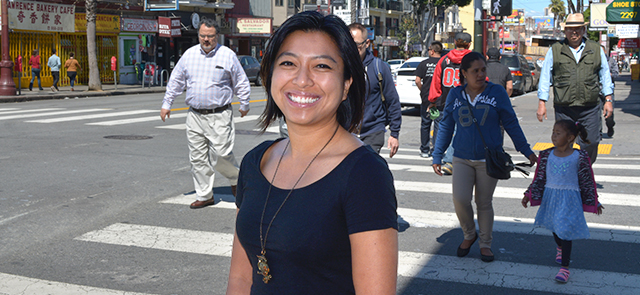 “My teaching newcomers to San Francisco is like I’m coming home. I was in classes like these when I emigrated from the Philippines at age 5. It’s like I am helping myself,” explains Everett Middle School teacher Jan Michelle Bautista of why she loves her job, and of the empathy she exhibits for her sixth- to eighth-grade science students.
“My teaching newcomers to San Francisco is like I’m coming home. I was in classes like these when I emigrated from the Philippines at age 5. It’s like I am helping myself,” explains Everett Middle School teacher Jan Michelle Bautista of why she loves her job, and of the empathy she exhibits for her sixth- to eighth-grade science students.
Raised in the Outer Richmond, Jan wanted to stay in the city she loved, but that created a major challenge on a teacher’s salary. In the summer of 2014, the 20-something was enjoying her new career while living solo in a $2,300 per month one-bedroom flat located Downtown. She tried coming up with ways to lower her rent, which ate up way too much of her take-home pay. There seemed to be no options – not in San Francisco, anyway.
Few of Jan’s contemporaries inspired confidence around housing possibilities. It seemed as if only her engineer friends had been able to move out on their own, with most still being compelled to head outside of San Francisco. Everybody else was still living with their folks.
Then Jan heard from Mission Promise Neighborhood Family Success Coach Roberto Aparicio, who is based at Everett, that MEDA’s Housing Opportunities team was coming to the school to lead a First-Time Homebuyers workshop to avail teachers of how they could potentially buy a place in San Francisco. At the workshop, housing counselor Juan Diego Castro spoke of San Francisco’s Downpayment Assistance Loan Program (DALP), which offers up to $200K, and the Teacher Next Door (TND) Program, with $20K toward a first-time home purchase. For the latter, a teacher signs an agreement to remain with SFUSD for a decade minimum; if they do so, there is no need to repay the money. If the teacher leaves sooner, full payback of $20K is required for years one through five, with prorated amounts of repayment starting year six. (The good news is that the TND program is being restarted in May 2016.)
Jan then took advantage of MEDA’s free one-on-one homeownership coaching. Castro also filled this role, going over Jan’s budget and then counseling her to move home for six months to save up for the rest of the needed downpayment. While Jan loves spending time with her extended family (really!), she knew it would be tough moving back to her childhood home after having been on her own. Jan had a flashback as she once again shared a room with siblings, plus the home was crowded with three generations of the Bautista clan. Despite these drawbacks, Jan bit the bullet, hoping it would truly be temporary.
It turns out Castro’s advice was pretty much spot on, as Jan closed on her new Nob Hill condo in February 2015, with a March move-in date. While Jan’s place is just 450 square feet and could use a kitchen remodel, it’s all hers.
There is another price to pay: it’s very tough to come up with the monthly mortgage payment on a teacher’s salary alone, so the industrious new homeowner has taken a second job working at a local supermarket. The days are long, but she can now stay in the city where she teaches.
That is not the case for most.
With real estate site Zillow today showing a median rent of $4,425 and home price of $1.12 million, a teacher’s salary just won’t cut it in San Francisco. Jan knows that many of the teachers at Everett now live in Oakland or other East Bay locales, meaning a long commute.
This can translate to not be able to attend student games, after-school events and educational meetings.
“I look forward to my Professional Learning Communities meetings, which are held after school hours. These meetings are where I share resources with other English Language Development teachers. Because I live in San Francisco, I can come to these meetings. Fellow teachers who live in the East Bay are forced to make a choice each day about getting home at a reasonable hour or staying for these kind of events. This is especially difficult for those with children,” states Jan.
Then there is keeping a connection to the community in which you teach — important to Jan, and other teachers like her. For instance, Jan takes the bus to work, sometimes seeing parents and students also on the way to Everett. “I ask them if homework was done last night,” Jan kids. She also can relate to her students’ daily life experiences, heading to the same eateries, parks and museums.
Jan knows that some dual-household-income teachers do not qualify for DALP or TND, as they make too much money to qualify, but do not earn enough to compete in San Francisco’s pricey market. This often means moving from the city.
“SFUSD puts plenty of money into training teachers, but if they leave the city, that knowledge is lost. If teachers don’t leave because they went back to grad school, then they most likely had to move away because they were evicted or wanted to buy a place and could do so only elsewhere. That’s quite the loss for San Francisco,” concludes Jan, grateful to MEDA for helping her be one of the enviable few who can actually live where they teach.






Leave a reply